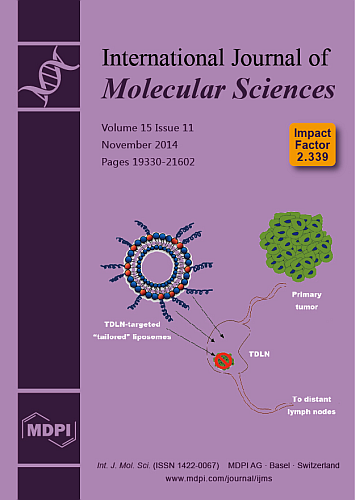Here, three novel cholesterol (Ch)/low molecular weight polyethylene glycol (PEG) conjugates, termed α, ω-cholesterol-functionalized PEG (Ch
2-PEG
n), were successfully synthesized using three kinds of PEG with different average molecular weight (PEG
600, PEG
1000 and PEG
2000). The
[...] Read more.
Here, three novel cholesterol (Ch)/low molecular weight polyethylene glycol (PEG) conjugates, termed α, ω-cholesterol-functionalized PEG (Ch
2-PEG
n), were successfully synthesized using three kinds of PEG with different average molecular weight (PEG
600, PEG
1000 and PEG
2000). The purpose of the study was to investigate the potential application of novel cationic liposomes (Ch
2-PEG
n-CLs) containing Ch
2-PEG
n in gene delivery. The introduction of Ch
2-PEG
n affected both the particle size and zeta potential of cationic liposomes. Ch
2-PEG
2000 effectively compressed liposomal particles and Ch
2-PEG
2000-CLs were of the smallest size. Ch
2-PEG
1000 and Ch
2-PEG
2000 significantly decreased zeta potentials of Ch
2-PEG
n-CLs, while Ch
2-PEG
600 did not alter the zeta potential due to the short PEG chain. Moreover, the
in vitro gene transfection efficiencies mediated by different Ch
2-PEG
n-CLs also differed, in which Ch
2-PEG
600-CLs achieved the strongest GFP expression than Ch
2-PEG
1000-CLs and Ch
2-PEG
2000-CLs in SKOV-3 cells. The gene delivery efficacy of Ch
2-PEG
n-CLs was further examined by addition of a targeting moiety (folate ligand) in both folate-receptor (FR) overexpressing SKOV-3 cells and A549 cells with low expression of FR. For Ch
2-PEG
1000-CLs and Ch
2-PEG
2000-CLs, higher molar ratios of folate ligand resulted in enhanced transfection efficacies, but Ch
2-PEG
600-CLs had no similar in contrast. Additionally, MTT assay proved the reduced cytotoxicities of cationic liposomes after modification by Ch
2-PEG
n. These findings provide important insights into the effects of Ch
2-PEG
n on cationic liposomes for delivering genes, which would be beneficial for the development of Ch
2-PEG
n-CLs-based gene delivery system.
Full article






